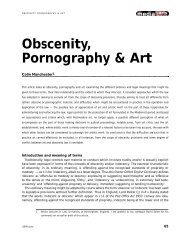Recent controversy over Phillip Gwynne's book Deadly, Unna? and ...
Recent controversy over Phillip Gwynne's book Deadly, Unna? and ...
Recent controversy over Phillip Gwynne's book Deadly, Unna? and ...
You also want an ePaper? Increase the reach of your titles
YUMPU automatically turns print PDFs into web optimized ePapers that Google loves.
Gray, ‘Imagination, Fraud <strong>and</strong> the Cultural Protocols Debate’<br />
Nevertheless, the author’s assertion of ownership <strong>over</strong> the story (‘it’s a white boy’s<br />
story <strong>and</strong> you don’t see Aboriginal culture unless you see them through his eyes’ 32 )<br />
suggests Aboriginal culture <strong>and</strong> experience being reinterpreted through a ‘white’ lens.<br />
The story does not have meaning until filtered <strong>and</strong> retold by a European observer:<br />
Aboriginal culture does not exist independently, but only insofar as it is capable of<br />
being understood by the dominant outsider. This type of reinterpretation is inevitable,<br />
of course, so long as the story is told by a European. The only alternative would be for<br />
the European storyteller to attempt to tell the story from an Aboriginal point of view,<br />
a narrative method now thoroughly discredited. 33 Given the history of these types of<br />
representations, <strong>and</strong> the political ramifications of these cultural stereotypes, it is no<br />
wonder Aboriginal people are suspicious.<br />
Cultural protocols <strong>and</strong> the pornography debate<br />
Several features of the debate about cultural protocols are reminiscent of the so called<br />
‘pornography debate’: that is, the question of whether restrictions on pornography<br />
should be regarded as a balance between freedom of speech <strong>and</strong> censorship, or<br />
whether a right to equality is also part of the balance. Like the cultural protocols<br />
debate, the pornography debate pits assertions of artistic freedom against historical<br />
<strong>and</strong> current abuse. Secondly, just as non-indigenous authors <strong>and</strong> filmmakers claim<br />
even distorted portrayals of indigenous people advance indigenous social <strong>and</strong> political<br />
rights, the makers of pornography claim their representations of women actually<br />
improve women’s social condition. 34 Thirdly, both the indigenous <strong>and</strong> pornography<br />
debates involve a conflict between formal <strong>and</strong> substantial models of the notion of<br />
‘equality’: that is, the extent to which the powerless position of women or indigenous<br />
people respectively needs to be taken into account in assessing the issue of ‘rights’.<br />
Catharine MacKinnon has argued that to regard the pornography debate as a ‘freedom<br />
of speech’ issue ignores the powerlessness of the ‘objects’ of pornography, both the<br />
32 <strong>Phillip</strong> Gwynne, quoted in n 13, above.<br />
33 Tom Kenneally has said that he would not have written The Chant of Jimmie Blacksmith in today’s<br />
political climate. Note also the SBS cultural protocols, compiled by Lester Bostock, above n 2 at p.31:<br />
‘All Aboriginal parts should be played by Aboriginal actors. There are no acceptable circumstances in<br />
today’s society which might justify using a non-Aboriginal actor to play a role in “black-face.” To do<br />
so is not only seen as negative stereotyping, but is also degrading to indigenous people.’<br />
34 In the indigenous context, this claim is made of sympathetic portrayals; in the context of<br />
pornography, the claim is rather that unsympathetic <strong>and</strong> abusive portrayals act as an outlet or safety<br />
valve for the violent feelings of men.



![ERIN O'DWYER [92] Introduction Striking a balance between ...](https://img.yumpu.com/14667367/1/184x260/erin-odwyer-92-introduction-striking-a-balance-between-.jpg?quality=85)


